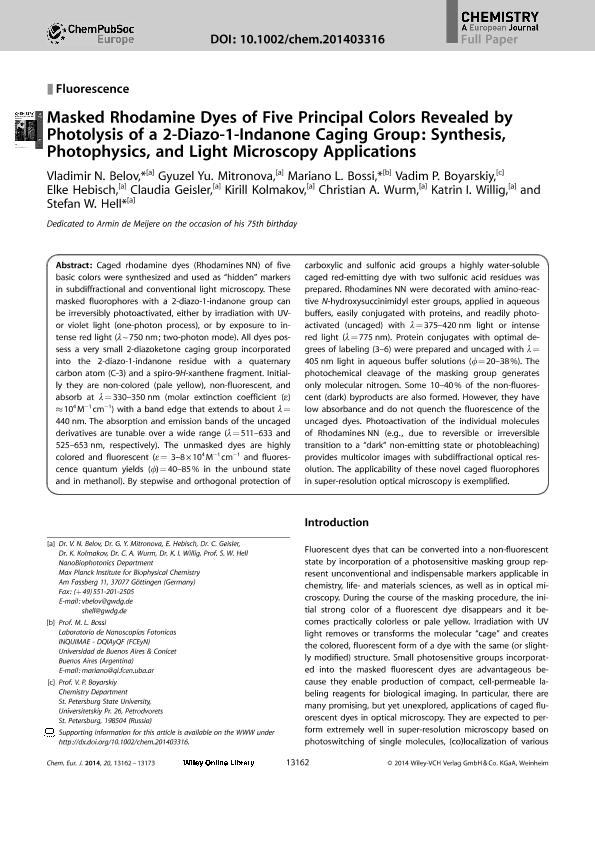Artículo
Masked Rhodamine Dyes of Five Principal Colors Revealed by Photolysis of a 2-Diazo-1-Indanone Caging Group: Synthesis, Photophysics, and Light Microscopy Applications
Belov, Vladimir N.; Mitronova, Gyuzel Yu.; Bossi, Mariano Luis ; Boyarskiy, Vadim P.; Hebisch, Elke; Geisler, Claudia; Kolmakov, Kirill; Wurm, Christian A.; Willig, Katrin I.; Hell, Stefan W.
; Boyarskiy, Vadim P.; Hebisch, Elke; Geisler, Claudia; Kolmakov, Kirill; Wurm, Christian A.; Willig, Katrin I.; Hell, Stefan W.
 ; Boyarskiy, Vadim P.; Hebisch, Elke; Geisler, Claudia; Kolmakov, Kirill; Wurm, Christian A.; Willig, Katrin I.; Hell, Stefan W.
; Boyarskiy, Vadim P.; Hebisch, Elke; Geisler, Claudia; Kolmakov, Kirill; Wurm, Christian A.; Willig, Katrin I.; Hell, Stefan W.
Fecha de publicación:
09/2014
Editorial:
Wiley VCH Verlag
Revista:
Chemistry- A European Journal
ISSN:
0947-6539
Idioma:
Inglés
Tipo de recurso:
Artículo publicado
Clasificación temática:
Resumen
Caged rhodamine dyes (Rhodamines NN) of five basic colors were synthesized and used as “hidden” markers in subdiffractional and conventional light microscopy. These masked fluorophores with a 2-diazo-1-indanone group can be irreversibly photoactivated, either by irradiation with UV- or violet light (one-photon process), or by exposure to intense red light (λ∼750 nm; two-photon mode). All dyes possess a very small 2-diazoketone caging group incorporated into the 2-diazo-1-indanone residue with a quaternary carbon atom (C-3) and a spiro-9H-xanthene fragment. Initially they are non-colored (pale yellow), non-fluorescent, and absorb at λ=330–350 nm (molar extinction coefficient (ε)≈104 M−1 cm−1) with a band edge that extends to about λ=440 nm. The absorption and emission bands of the uncaged derivatives are tunable over a wide range (λ=511–633 and 525–653 nm, respectively). The unmasked dyes are highly colored and fluorescent (ε= 3–8×104 M−1 cm−1 and fluorescence quantum yields (ϕ)=40–85 % in the unbound state and in methanol). By stepwise and orthogonal protection of carboxylic and sulfonic acid groups a highly water-soluble caged red-emitting dye with two sulfonic acid residues was prepared. Rhodamines NN were decorated with amino-reactive N-hydroxysuccinimidyl ester groups, applied in aqueous buffers, easily conjugated with proteins, and readily photoactivated (uncaged) with λ=375–420 nm light or intense red light (λ=775 nm). Protein conjugates with optimal degrees of labeling (3–6) were prepared and uncaged with λ=405 nm light in aqueous buffer solutions (ϕ=20–38 %). The photochemical cleavage of the masking group generates only molecular nitrogen. Some 10–40 % of the non-fluorescent (dark) byproducts are also formed. However, they have low absorbance and do not quench the fluorescence of the uncaged dyes. Photoactivation of the individual molecules of Rhodamines NN (e.g., due to reversible or irreversible transition to a “dark” non-emitting state or photobleaching) provides multicolor images with subdiffractional optical resolution. The applicability of these novel caged fluorophores in super-resolution optical microscopy is exemplified.
Palabras clave:
Bioconjugation
,
Fluorescence
,
Photolysis
,
Rhodamines
Archivos asociados
Licencia
Identificadores
Colecciones
Articulos(INQUIMAE)
Articulos de INST.D/QUIM FIS D/L MATERIALES MEDIOAMB Y ENERGIA
Articulos de INST.D/QUIM FIS D/L MATERIALES MEDIOAMB Y ENERGIA
Citación
Belov, Vladimir N.; Hebisch, Elke; Mitronova, Gyuzel Yu.; Bossi, Mariano Luis; Boyarskiy, Vadim P.; Geisler, Claudia; et al.; Masked Rhodamine Dyes of Five Principal Colors Revealed by Photolysis of a 2-Diazo-1-Indanone Caging Group: Synthesis, Photophysics, and Light Microscopy Applications; Wiley VCH Verlag; Chemistry- A European Journal; 20; 41; 9-2014; 13162-13173
Compartir
Altmétricas



